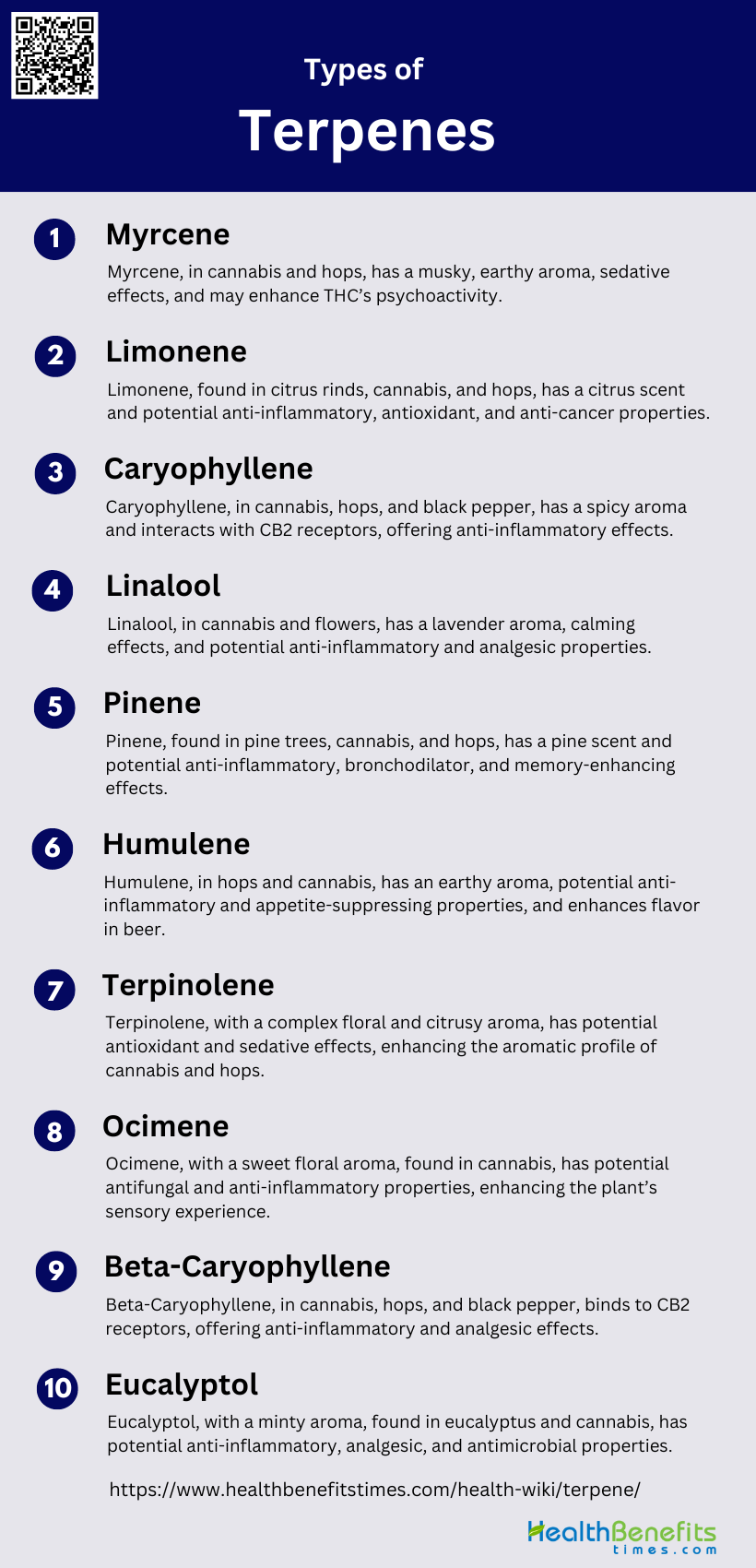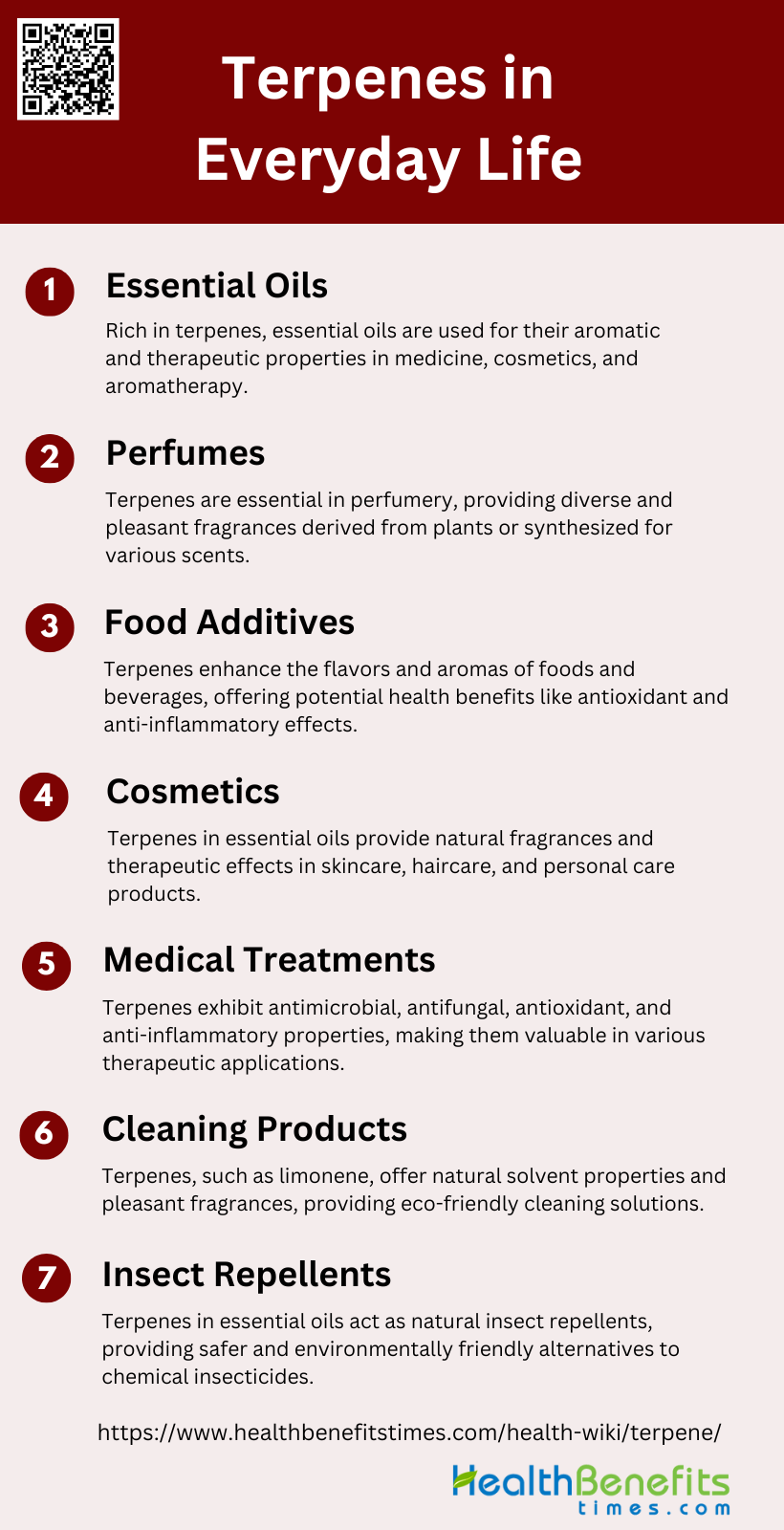Terpenes are a diverse class of organic compounds produced by a variety of plants and some insects, characterized by their strong odors. These compounds are the primary constituents of essential oils and contribute to the aroma and flavor of many plants, including cannabis, citrus fruits, and conifers. Terpenes play a crucial role in plant defense mechanisms against herbivores and pathogens, and they also attract pollinators. In addition to their ecological functions, terpenes have significant applications in medicine, aromatherapy, and as natural insecticides. They are known for their potential therapeutic properties, including anti-inflammatory, analgesic, and antimicrobial effects, making them a subject of interest in pharmacological research.
Chemical Structure of Terpene
Terpenes are a diverse and extensive class of natural compounds characterized by their unique chemical structures, which are primarily composed of isoprene units (C5H8). These compounds can be classified based on the number of carbon atoms they contain, such as monoterpenes (C10), sesquiterpenes (C15), diterpenes (C20), triterpenes (C30), and tetraterpenes (C40). The biosynthesis of terpenes begins with the formation of oligoprenyl diphosphates, which undergo ionization to form reactive carbocation intermediates. These intermediates can then participate in a series of complex reactions, including cyclization, hydride migrations, and rearrangements, ultimately leading to the formation of diverse terpene structures. Terpenes are not only significant for their structural variety but also for their biological roles and industrial applications, ranging from flavors and fragrances to pharmaceuticals and biofuels. The intricate processes involved in terpene biosynthesis and the resulting chemical diversity underscore the importance of these compounds in both natural and synthetic contexts.
Types of Terpenes
Terpenes are aromatic compounds found in many plants, though many people commonly associate them with cannabis. These compounds play a crucial role in the plant’s survival, attracting pollinators and deterring predators. There are numerous types of terpenes, each with unique characteristics and benefits, including:
1. Myrcene
Myrcene is a monoterpene commonly found in various plants, including cannabis and hops. It is known for its musky, earthy aroma and is a significant component of the essential oils in these plants. Myrcene has been identified as one of the major terpenes in cannabis, contributing to its distinctive smell and potential therapeutic effects. In hops, myrcene is also a key terpene, influencing the aroma and flavor of beer. Studies have shown that myrcene can have sedative effects and may enhance the psychoactive properties of THC in cannabis.
2. Limonene
Limonene is a monoterpene with a strong citrus scent, commonly found in the rinds of citrus fruits and various other plants. It is one of the primary terpenes in cannabis and is also prevalent in hops. Limonene is known for its potential therapeutic benefits, including anti-inflammatory, antioxidant, and anti-cancer properties. It is also used in aromatherapy for its uplifting and stress-relieving effects. The presence of limonene in cannabis and hops contributes to their aromatic profiles and may influence their medicinal qualities.
3. Caryophyllene
Caryophyllene, specifically β-caryophyllene, is a sesquiterpene found in many plants, including cannabis, hops, and black pepper. It has a spicy, woody aroma and is unique among terpenes for its ability to interact with the CB2 receptors in the endocannabinoid system, potentially offering anti-inflammatory and analgesic effects. Caryophyllene is a major component in the essential oils of cannabis and hops, contributing to their distinctive scents and potential health benefits. Its presence in these plants makes it a subject of interest for both the brewing and medical industries.
4. Linalool
Linalool is a monoterpene alcohol with a floral, lavender-like aroma, commonly found in many flowers and spice plants. It is present in cannabis and has been identified in the essential oils of hops as well. Linalool is known for its calming and sedative effects, making it a popular choice in aromatherapy for reducing anxiety and stress. Additionally, it has potential anti-inflammatory and analgesic properties, which may contribute to the therapeutic effects of cannabis and hops. Its pleasant aroma also enhances the sensory experience of these plants.
5. Pinene
Pinene, including both α-pinene and β-pinene, is a bicyclic monoterpene with a distinctive pine scent. It is one of the most common terpenes in nature, found in pine trees, cannabis, and other plants. Pinene is known for its potential anti-inflammatory, bronchodilator, and memory-enhancing effects. In cannabis, pinene contributes to the plant’s aroma and may counteract some of the cognitive effects of THC. Its presence in hops also influences the flavor and aroma of beer, making it a valuable component in brewing.
6. Humulene
Humulene, also known as α-humulene, is a sesquiterpene with an earthy, woody aroma, commonly found in hops and cannabis. It is one of the primary terpenes in hops, significantly contributing to the aroma and flavor of beer. Humulene is known for its potential anti-inflammatory and appetite-suppressing properties, making it a subject of interest for medical research. Its presence in cannabis and hops enhances their aromatic profiles and may contribute to their therapeutic effects.
7. Terpinolene
Terpinolene is a monoterpene with a complex aroma that can be described as floral, herbal, and slightly citrusy. It is found in various plants, including cannabis and hops. Terpinolene is less common than other terpenes but still plays a significant role in the aromatic profile of these plants. It is known for its potential antioxidant and sedative effects, which may contribute to the therapeutic properties of cannabis. In hops, terpinolene adds to the complexity of the beer’s aroma and flavor.
8. Ocimene
Ocimene is a monoterpene with a sweet, floral, and herbaceous aroma, found in many plants, including cannabis. It is less prevalent in hops but still contributes to the overall terpene profile of the plant. Ocimene is known for its potential antifungal and anti-inflammatory properties, making it a valuable component in the therapeutic effects of cannabis. Its pleasant aroma also enhances the sensory experience of cannabis and other plants where it is found.
9. Beta-Caryophyllene
Beta-caryophyllene, often referred to simply as caryophyllene, is a sesquiterpene with a spicy, woody aroma. It is found in cannabis, hops, and black pepper, among other plants. Beta-caryophyllene is unique for its ability to bind to CB2 receptors in the endocannabinoid system, offering potential anti-inflammatory and analgesic effects. Its presence in cannabis and hops contributes to their distinctive scents and potential health benefits, making it a subject of interest for both the brewing and medical industries.
10. Eucalyptol
Eucalyptol, also known as 1,8-cineole, is a monoterpene with a fresh, minty aroma, commonly found in eucalyptus, cannabis, and other plants. It is known for its potential anti-inflammatory, analgesic, and antimicrobial properties. In cannabis, eucalyptol contributes to the plant’s aroma and may enhance its therapeutic effects. Its presence in other plants, such as eucalyptus, makes it a popular choice in traditional medicine and aromatherapy for its refreshing and medicinal qualities.
Benefits of Terpenes
Terpenes are natural compounds found in plants that contribute to their aroma, flavor, and color. Beyond their sensory appeal, terpenes offer a range of health benefits, from anti-inflammatory properties to stress relief. Here are some of the key benefits of terpenes:
1. Anti-inflammatory Effects
Terpenes have shown significant anti-inflammatory properties, making them promising candidates for treating various inflammatory diseases. Studies have demonstrated that terpenes can reduce inflammation by decreasing the release of pro-inflammatory cytokines such as nuclear transcription factor-kappa B, interleukin 1, and tumor necrosis factor-alpha. These compounds are found in plants like tea, cannabis, thyme, and citrus fruits, and their anti-inflammatory effects are attributed to their ability to modulate inflammatory signaling mechanisms. Given the side effects of conventional anti-inflammatory drugs, terpenes offer a natural alternative with fewer adverse effects.
2. Antimicrobial and Antifungal Properties
Terpenes exhibit potent antimicrobial and antifungal activities, making them valuable in combating pathogens, including those resistant to conventional antibiotics. These compounds, often found in essential oils, have been reported to have bacteriostatic and bactericidal effects against various pathogens. The antimicrobial action of terpenes is attributed to their ability to disrupt microbial cell membranes and interfere with essential cellular processes. This makes terpenes a promising resource in the fight against antimicrobial resistance (AMR) and a potential alternative to traditional antimicrobial agents.
3. Anticancer Potential
Terpenes have shown promising anticancer potential through various mechanisms, including the induction of apoptosis, inhibition of cell proliferation, and suppression of metastasis. These compounds have been identified as cancer chemopreventive agents, capable of modulating signaling pathways involved in cancer progression. The diverse structural nature of terpenes allows them to interact with multiple molecular targets, making them effective against different types of cancer. Further research is needed to fully understand their mechanisms and optimize their use in cancer therapy.
4. Neuroprotective Effects
Certain terpenes, such as pinene and linalool, have demonstrated neuroprotective effects, making them potential candidates for treating neurological and psychiatric disorders. These compounds exhibit antioxidant, anti-inflammatory, and neuroprotective properties, which can benefit conditions like Alzheimer’s disease, stroke, and neurodegeneration. Terpenes influence neurotransmitter, inflammatory, and neurotrophic signals, contributing to their neuroprotective effects. Although most evidence comes from preclinical studies, the potential of terpenes in brain health warrants further investigation through well-designed clinical trials.
5. Respiratory Benefits
Terpenes, particularly those found in forest aerosols, have been shown to offer respiratory benefits by reducing inflammation and improving lung function. These compounds, known as biogenic volatile organic compounds (BVOCs), are abundant in forested areas and have been linked to the therapeutic effects of forest bathing. Terpenes can alleviate respiratory inflammation and conditions such as asthma and bronchitis by modulating inflammatory pathways and enhancing respiratory health. The therapeutic potential of terpenes in respiratory diseases highlights their importance in natural medicine.
6. Stress and Anxiety Relief
Terpenes like linalool and pinene have been found to possess anxiolytic properties, helping to alleviate stress and anxiety. These compounds can modulate neurotransmitter systems and exhibit psychoactive effects without causing intoxication. The calming and relaxing effects of terpenes make them useful in managing stress-related disorders and improving mental well-being. The potential of terpenes in stress and anxiety relief underscores their role in holistic and integrative approaches to mental health.
7. Pain Relief
Terpenes have been extensively studied for their analgesic properties, making them effective in pain management. These compounds can modulate pain pathways and reduce pain perception through various mechanisms, including anti-inflammatory and neuroprotective actions. Terpenes have shown promise in treating chronic pain conditions such as arthritis, neuropathic pain, and migraine. The development of terpene-based analgesics offers a natural alternative to conventional pain medications, with the potential for fewer side effects and better patient compliance.
Terpenes in Everyday Life
Terpenes are versatile compounds found in many plants, contributing to their aroma and flavor. These natural substances are used in a variety of everyday products, enhancing their effectiveness and appeal. Here are some common applications of terpenes:
1. Essential Oils
Essential oils, rich in terpenes, are widely used for their aromatic and therapeutic properties. They are extracted from plants through steam distillation and contain a variety of volatile molecules such as monoterpenes and sesquiterpenes. These oils have been utilized for centuries in various applications, including medicinal, cosmetic, and food industries. Essential oils exhibit a range of biological activities, including antimicrobial, antifungal, antioxidant, and anti-inflammatory properties, making them valuable in health and wellness products. Additionally, they are used in aromatherapy to promote relaxation and well-being.
2. Perfumes
Terpenes are fundamental components in the perfumery industry due to their diverse and pleasant fragrances. Monoterpenes and sesquiterpenes, which are major constituents of essential oils, are extensively used to create fine perfumes. These compounds are extracted from plants and refined to produce a variety of scents. Synthetic variations and derivatives of natural terpenes further expand the range of fragrances available in perfumery. The versatility and abundance of terpenes make them indispensable in the creation of perfumes that cater to different preferences and occasions.
3. Food Additives
Terpenes play a significant role in the flavor industry as food additives. They are responsible for the distinct flavors and aromas of many foods and beverages. Terpenes such as limonene, carvone, and menthol are commonly used to enhance the taste and smell of food products. These compounds are not only valued for their sensory properties but also for their potential health benefits, including antioxidant and anti-inflammatory effects. The use of terpenes in food additives helps in creating appealing and flavorful products that meet consumer demands.
4. Cosmetics
In the cosmetic industry, terpenes are prized for their aromatic and bioactive properties. Essential oils containing terpenes are used in a wide range of cosmetic products, including skincare, haircare, and personal care items. These compounds provide natural fragrances and contribute to the therapeutic effects of cosmetics, such as moisturizing, anti-aging, and anti-inflammatory benefits. The increasing consumer preference for natural and organic products has further boosted the use of terpenes in cosmetics, making them a key ingredient in the formulation of high-quality and effective beauty products.
5. Medical Treatments
Terpenes have shown significant potential in medical treatments due to their diverse biological activities. They exhibit antimicrobial, antifungal, antioxidant, and anti-inflammatory properties, making them useful in various therapeutic applications. Some terpenes have been found to possess anticancer properties, helping to prevent the formation or progression of tumors. Additionally, terpenes are used in the development of reduced-risk pesticides and other medicinal products. Their ability to interact with biological systems and provide health benefits makes them valuable in the field of medicine.
6. Cleaning Products
Terpenes are commonly used in cleaning products for their natural solvent properties and pleasant fragrances. Compounds such as limonene, derived from citrus peels, are effective in breaking down grease and grime, making them ideal for household cleaners. The antimicrobial properties of certain terpenes also contribute to the disinfecting capabilities of cleaning products. The use of terpenes in cleaning products offers an eco-friendly alternative to synthetic chemicals, providing effective cleaning solutions while minimizing environmental impact.
7. Insect Repellents
Essential oils rich in terpenes are widely used as insect repellents due to their natural insecticidal and repellent properties. Terpenes such as eugenol, caryophyllene, and thymol have been shown to be effective against various insect species, including mosquitoes and agricultural pests. These compounds work by disrupting the nervous system of insects, leading to repellency and reduced mobility. The use of terpene-based insect repellents offers a safer and environmentally friendly alternative to conventional chemical insecticides, making them popular among organic growers and environmentally conscious consumers.





